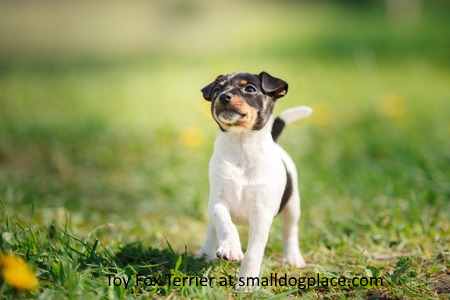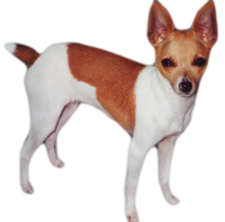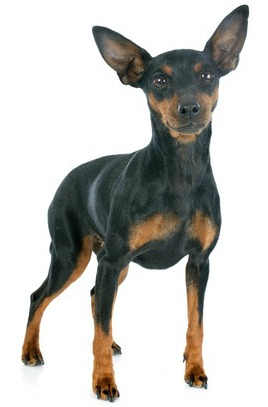- Small Dog Place Home
- A to Z Breed List
- Toy Fox Terrier
Toy Fox Terrier
Toy Fox Terrier by Janice Jones |Last updated 07-07-2022
A true American made breed; the toy fox terrier is spunky, eager to please, intelligent and the perfect dog for those who hate to groom.
A real entertainer, smuggler, lap dog, and exercise partner, this companion has a lot to offer.
However, beware, with all that enthusiasm for life, all that playfulness and curiosity, there is always a downside.
 Three Toy Fox Terriers
Three Toy Fox TerriersA true American made breed; the toy fox terrier is spunky, eager to please, intelligent and the perfect dog for those who hate to groom.
A real entertainer, smuggler, lap dog, and exercise partner, this companion has a lot to offer.
However, beware, with all that enthusiasm for life, all that playfulness and curiosity, there is always a downside.
Any highly intelligent breed can get bored easily, so anyone looking for a lively, playful companion do expect to do some training and socialization early.
This is one tiny dog, with adult size ranging from 3 to 9 pounds and 8 to 11 inches tall, they make a great apartment dog but do equally well in a family home or on the farm.
They do well with older children, but due to their small size, families with very small children might want to consider another breed. Being somewhat squirmy, a small child could drop them easily causing damage to their slender bodies.
You will life with a Toy Fox Terrier will never be dull. Even circus clowns found this breed to be the perfect show companion, teaching them to do jumping tricks and even walk on a tight rope.
They learn easily, so training is not difficult, but if training is not your cup of tea, consider another breed. These dogs have known to be destructive indoors and out, especially if left alone for long periods.
After all, they are terriers, and they like to dig, chase, bark, and investigate anything novel. Do not overlook puppy proofing your home before the big day. Truly, the epitome of the big dog attitude in a small dog package, be prepared to help protect him from himself.
They excel in agility, and other doggie sports such as flyball and rally. Unlike most small breed dogs, they are generally easy to housetrain which is a big plus. For those without immediate access to the outdoors, these dogs do well with litter box or pad training. In 2013, they were ranked number 107 in popularity with the American Kennel Club
Quick Facts About the Toy Fox Terrier
Other Names Used: Amer-Toy, TFT, American Toy Terrier
Affiliation: Toy with AKC
Size
Height: 8 1/2 inches to 11 inches (21.5–29.2 cm)
Weight: 3 to 9 pounds
Coat Type: Short, sleek
Colors: Five different combinations with white as the predominant color: White and Tan, White and Black, White, Black and Tan, White and Chocolate, and White, Chocolate and Tan
Country of Origin: USA
Activity Level: Moderate
Life Expectancy: Up to 15 years
Good with Children: Older Children, not very young children
Good with other pets: Yes
Shedding: Moderate
History
Toy Fox Terriers were developed in the United States during the 1930s to be used on the farm to hunt and kill rats and other small vermin as well as hunt squirrels.
Toy Fox Terriers were developed by crossing small Smooth Fox Terriers (most likely the runts of the litter) with Chihuahua and Manchester Terriers. Other breeds that may have been used included the Miniature Pincher and the Italian Greyhound.
First registered with The United Kennel Club in 1936, but did not gain American Kennel Club recognition until 2003, becoming AKC’s 148th breed.
Personality of the Toy Fox Terrier
The Toy Fox Terrier blends the feisty nature of a terrier and the loving, devoted nature of the toy into a package that is neither terrier or toy. This blending created a unique combination of characteristics.
| Traits | Rating |
|---|---|
| Playfulness | |
| Affection Level | |
| Friendliness Towards Strangers | |
| Good with Children | |
| Good with Other Dogs | |
| Good for First Time Owners | |
| Exercise Needed | |
| Ease of Training | |
| Watch Dog Ability | |
| Grooming Requirements | |
| Shedding | |
| Cold Tolerant | |
| Heat Tolerant |
Explanations for At a Glance Ratings
- Playfulness: Most=5 Less=1
- Affection: Most=5 Least=1
- Friendliness Towards Strangers: Most=5 Least=1
- Good with Children: Good=5 Not Good=1
- Good with Other Dogs: Good=5 Not Good=1
- Good for First Time Owners: Good=5 Not Good=1
- Amount of Exercise Required: Much=5 Minimal=1
- Ease of Training: Easy=5 Difficult=1
- Watch Dog Ability: Excellent=5 Poor=1
- Grooming Needs: Extensive=5 Minimal=1
- Shedding: Heavy Shedding=5 Minimal Shedding=1
- Cold Tolerance: Cold Well Tolerated=5 Poorly Tolerated=1
- Heat Tolerance: Heat Well Tolerated=5 Poorly Tolerated=1
They love to snuggle on your lap, but they are equally happy chasing squirrels, digging in the dirt and entertaining you with their great athletic abilities.
However, no two Toy Fox Terriers are truly alike. Some may be more terrier-like, and others are happy to be couch potatoes. Usually reputable breeders know their puppies well and can help steer you towards a puppy with the traits you desire.
They are a warm weather breed, preferring warmer climates especially those where it does not rain. They hate getting wet and can chill easily. That does not mean that they cannot live anywhere—they will only need a little sweater or coat on those cold winter days.
They bond strongly to their person or family and do not like being apart for too long. Since they do bark (and some do more so than others) they make good guard dogs. Training early on helps with the barking problem. Being a terrier, they are also territorial, so be prepared to help protect your tiny TFT even from himself. He does not realize he is small.
These dogs are smart and like to please, so training is usually easy. Basic training should begin the day you bring the dog home and continue indefinitely. They respond to a consistent, positive, gentle approach. Prior to bringing the puppy home, we recommend you puppy-proof your home and have a plan for socializing him after the big day.
They love comfort and will easily win your heart and your pillow, often snuggling under the covers if possible. If sharing your bed is not an option, consider a warm, comfortable bed or crate and train early.
Grooming

This is the perfect dog for anyone who would rather play with their dog than groom them. A quick brushing once a week is enough to keep shedding hairs in check and remove dead hairs.
An occasional bath is needed when they are especially dirty or have rolled in something unpleasant. Other than that, nails will need to be clipped, teeth brushed, and ears cleaned periodically. You are done!
Health Concerns
This is a healthy breed, living to a ripe old age of 15, but like all dogs, they are prone to some genetic disorders. The list below does not include infectious diseases or other conditions that any dog can get. Toy Fox Terrier owners and breeders reported the following list of diseases.
Primary Lens Luxation
This is a painful condition that causes blindness in many breeds especially terrier type breeds. When the tiny fibers (called zonular fibers) that hold the lens of the eye in place collapse, the lens moves If the lens falls into the anterior chamber of the eye (front of eye) glaucoma and loss of vision occur.
Periodontal Disease
Gum disease in this breed is common because tarter tends to build up on the teeth. Owners can prevent this by regularly brushing the TFT’s teeth. This breed will likely need professional cleanings at the veterinary hospital.
Demodectic Mange
Considered to have a genetic component, this skin disorder is caused by a microscopic mite. All dogs have small amounts of these mites that life in their hair follicles, but when the mites begin to increase, they cause problems.
Demodicosis is the name given to the condition, and it can be a localized infection or generalized mange covering a large part of the body. Two types have been reported. The Juvenile onset demodicosis begins in dogs as young as three months of age. The Adult onset mange does not occur until the dog is over five years old and is usually in combination with another disease. Treatment consists of medications and dips.
Patellar Luxation
Patellar luxation is common in small breed dogs and refers to a condition where there is a dislocation of the kneecap either in one or both legs.
Mild forms usually do not require treatment, but when the problem becomes more severe, the dog may experience pain and limping. Treatment may involve rest, medication, and surgery as a last resort.
Legg-Calve Perthese Disease
Similar to hip dysplasia in that both involve the hip joint, Legg-Calve Perthese Disease leads to the changes in the head of the femur or leg bone. This ends up causing pain and limping and has no known cure at this time.
Treatment involves medication to reduce inflammation and ease pain. Restricting movement also helps make the dog more comfortable. Surgery is also an option and involves removing the head of the femur.
von Willebrand's Disease
This disease is known as an autosomal recessive genetic problem, meaning that the trait must be present in both the mother and the father, even though neither parent may show signs of the disease.
Less severe than the disease known as Hemophilia, affected dogs, (and people) with von Willebrand’s disease will bleed abnormally—more profusely than normal.
This can cause problems in many areas of life from clipping nails to undergoing surgery.
Congenital Hypothyroidism with Goiter (CHG)
This is really a problem for breeders as most puppies die by the age of three weeks. Adult dogs may carry the trait and not show any signs of the disease. This would not be a problem for a spayed or neutered dog, only for dogs used for breeding purposes.
Puppies that are born to parents who are both carriers of the condition are lethargic, have larger heads, do not open their eyes or ears, and develop a swelling on the underside of their neck.
Even with treatment, the swelling or goiter will increase and eventually constrict the airway causing death. Breeders with these puppies elect to have them euthanized.
Pros
- Lovable, loyal, playful, entertaining
- Can live most anywhere
- Minimum grooming required
- Easy to train and housebreak
- Relatively healthy
Cons
- Retained some terrier instincts such as strong prey drive, digging
- Barker
- Require much socialization and training
References/Breed Club
If you enjoyed this breed, you might want to check out these other breeds.
About Janice (author and voice behind this site)
Having lived with dogs and cats most of her life, Janice served as a veterinary technician for ten years in Maryland and twelve years as a Shih Tzu dog breeder in Ohio.
Her education includes undergraduate degrees in Psychology with a minor in biology, Early Childhood Education, and Nursing, and a master's in Mental Health Counseling.
She is a lifelong learner, a dog lover, and passionate about the welfare of animals. Her favorite breed for over 50 years has been the Shih Tzu, but she has also lived with Poodles, Maltese, Yorkshire Terriers, Beagles, English Bulldogs, Carin Terriers, and a Cocker Spaniel.
When not writing, reading, and researching dog-related topics, she likes to spend time with her eight Shih Tzu dogs, husband, and family, as well as knitting and crocheting. She is also the voice behind Miracle Shih Tzu and Smart-Knit-Crocheting
Does This Article Deserve Your Thumbs Up?
We always appreciate your support and encouragement. Your thumbs up means so much to us. Please like this article.
If you find this page or any page on Small Dog Place Helpful, or useful in anyway, I'd love it if you would click the small heart found on the bottom right of each page.
You can also share or bookmark this page -- just click on the:

Free Monthly Newsletter
Sign Up for Our Free Newsletter and get our Free Gift to You.
my E-book, The Top 10 Mistakes People Make When Choosing a Dog (and how to avoid them)






